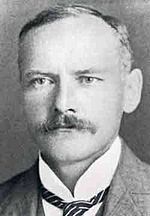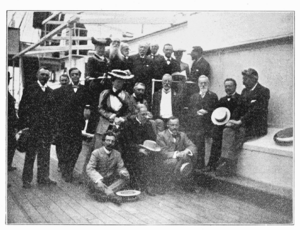Ernest William Brown facts for kids
Quick facts for kids
Ernest William Brown
|
|
|---|---|

Ernest William Brown, from the American Mathematical Society
|
|
| Born | 29 November 1866 |
| Died | 22 July 1938 (aged 71) |
| Nationality | English |
| Citizenship | United Kingdom United States |
| Alma mater | Christ's College, Cambridge |
| Known for | Lunar theory Celestial mechanics |
| Awards | Royal Medal (1914) James Craig Watson Medal (1937) Fellow of the Royal Society (1897) |
| Scientific career | |
| Fields | Mathematics Astronomy |
| Doctoral advisor | George Howard Darwin |
| Influenced | Wallace John Eckert |
| Signature | |
Ernest William Brown (born November 29, 1866 – died July 22, 1938) was a brilliant English mathematician and astronomer. He spent most of his working life in the United States. In 1923, he became an American citizen. Brown's main work was studying how the Moon moves. He created very exact tables that showed the Moon's path. He also looked at how other planets move and figured out the paths of Trojan asteroids.
Contents
Life and Career of Ernest William Brown
Ernest William Brown was born in Hull, England. He was born on November 29, 1866. He was the second of four children. His father was a farmer who later sold timber. When Ernest was almost four, his mother and younger brother died. They died from scarlet fever. Ernest and his two sisters were cared for by an aunt. His father remarried five years later.
Ernest Brown's Education and Early Work
Brown went to Totteridge Park School in Hertfordshire. He also studied at Hull and East Riding College. After school, he went to Christ's College in Cambridge. In 1887, he graduated with top honors in mathematics. He continued his studies at Cambridge. He worked with George Howard Darwin. In 1888, Darwin suggested he study the Moon's motion. This idea changed Brown's life.
Brown became a fellow of Christ's College in 1889. He was also chosen as a Fellow of the Royal Astronomical Society. He earned his master's degree in 1891. Then, he left Cambridge to teach mathematics. He taught at Haverford College in Pennsylvania. He quickly became a Professor of Mathematics in 1893. He often returned to Cambridge in the summer. He would stay with his old teacher, Darwin.
Ernest Brown's Study of the Moon's Motion
At Haverford, Brown kept studying how the Moon moves. He carefully reviewed the work of earlier scientists. These included Hill, de Pontécoulant, Delaunay, and Hansen. He showed his great knowledge in his first big book. It was called An Introductory Treatise on the Lunar Theory. He published it in 1896, when he was under 30. The next year, he became a Fellow of the Royal Society.
As Brown worked, he planned a new theory for the Moon's motion. He published this in many papers. These papers appeared in the Memoirs of the Royal Astronomical Society. This was between 1897 and 1908. In 1907, he became a Professor of Mathematics at Yale University. He got funding from Yale for a huge project. This project was to calculate detailed tables of the Moon's motion. These tables were based on his new theory. After 12 years and a lot of money, his main work was finished. His Tables of the Motion of the Moon came out in 1919.
Differences Between Theory and Observation
Brown wanted to create an exact ephemeris for the Moon. An ephemeris is a table that shows where a celestial object will be at certain times. He based it only on the rules of gravity. For the main problem of the Earth-Moon-Sun system, he calculated very small details. He included effects from other planets like Jupiter and Venus. He also thought about the Earth and Moon not being perfect spheres.
Observations showed that Brown's tables were better than older ones. But there was still a big difference. The Moon's average position was off by about 10 arcseconds. An arcsecond is a tiny unit for measuring angles. Scientists added a "great empirical term" to fix this. It was a guess, but it helped the tables match observations. This must have been disappointing for Brown.
Long ago, Edmond Halley noticed something strange. The Moon seemed to be speeding up. This "secular acceleration" couldn't be explained by gravity alone. Simon Newcomb thought it was because the Earth was slowing down. The Earth's spin was slowing due to friction from the tides. This meant the Moon wasn't speeding up. Instead, time, as measured by Earth's longer days, seemed to be slowing down.
Brown studied this problem a lot. He thought scientists should watch lunar occultations more closely. Occultations are when the Moon passes in front of a star. He also thought if the Earth's spin was changing, other observations would be affected. This was partly true for observations of Mercury passing in front of the Sun. Brown wasn't sure at first. But he later agreed with Newcomb. He found that the Earth's spin was slowing down. It also had random, unexpected changes. He published these findings in 1926. Later work proved he was right. Now, astronomers use different ways to measure time. Universal Time is based on Earth's spin. Terrestrial Time is a steady measure of time passing.
Brown's Later Work and Teamwork
Brown was an active member of the American Mathematical Society. He was its president from 1915 to 1916.
He stayed a professor at Yale until he retired in 1932. He kept working on the Moon. He also studied how planets move around the Sun. In 1933, he published a book called Planetary Theory. He wrote it with Clarence Shook. This book explained resonance in planetary orbits. It also looked at the special case of the Trojan asteroids. In 1937, he won the James Craig Watson Medal. This award came from the US National Academy of Sciences.
One of Brown's students was Wallace John Eckert. Eckert later taught at Columbia University. He helped make astronomical calculations faster. He did this by using early digital computers.
Ernest Brown's Private Life

Brown never married. For most of his life, he lived with his unmarried younger sister, Mildred. She took care of his home. She made sure he wasn't bothered by worries. She "spoiled him" by taking care of everything. When he was young, he loved rowing and climbing mountains. He was a good pianist and played until a few years before he died. He loved music and led the New Haven Oratorio Society for a while. Brown also played chess very well. He enjoyed reading detective stories.
He loved to travel. He often crossed the Atlantic Ocean between the United States and Great Britain. In 1905, he went on a long trip. He visited South Africa and other parts of Africa. He went with other scientists from the British Science Association.
His daily routine was quite unusual. People described it like this:
He usually went to bed early. So, he would wake up between three and five in the morning. He would drink strong coffee from a thermos bottle. Then, he would start working without leaving his bed. He would smoke many cigarettes. His serious science work was done before he got up for breakfast at nine o'clock.
Ernest Brown's Death
Brown smoked a lot. He had breathing problems for much of his life. He was sick for most of the six years after he retired. He died in New Haven, Connecticut in 1938. His sister, Mildred, had died a few years before him. His only close family left was his older sister, Ella Yorke. She had moved to New Zealand with her husband in the 1890s.
Ernest Brown's Legacy and Impact
Brown's Tables were very important. Most national space agencies started using them in 1923. They used them to calculate the Moon's position. These tables were used, with some changes, until 1983. When digital computers came along, scientists used Brown's original math formulas. They used these formulas to calculate directly instead of using the tables. This made the results even more exact. The original tables had some small guesses. This was to make manual calculations easier back then.
By the mid-1900s, scientists understood the difference between Universal and Ephemeris Time. The "troublesome empirical terms" were removed. More changes were made to Brown's theory. These came from better observations of space constants. Also, Brown's original math was reworked to get more precise numbers.
Finally, in 1984, Brown's work was replaced. New data from lunar laser ranging was used. Also, new computer methods were developed. These new methods calculated the Moon's path even better.
Honours and Awards for Ernest Brown
Awards
- Adams Prize (1907)
- Gold Medal of the Royal Astronomical Society (1907)
- Bruce Medal (1920)
- James Craig Watson Medal (1936)
Named After Him
- The crater Brown on the Moon
- Asteroid 1643 Brown
- Brown lunation number
See also
 In Spanish: Ernest William Brown para niños
In Spanish: Ernest William Brown para niños

